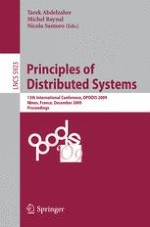2009 | Buch
Principles of Distributed Systems
13th International Conference, OPODIS 2009, Nîmes, France, December 15-18, 2009. Proceedings
herausgegeben von: Tarek Abdelzaher, Michel Raynal, Nicola Santoro
Verlag: Springer Berlin Heidelberg
Buchreihe : Lecture Notes in Computer Science
